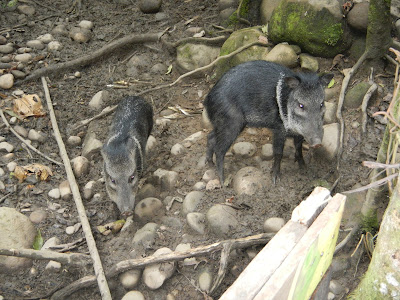Well, as promised, I will finally begin to blog about the animals that we take care of at the Sacha Yacu animal rescue center where I am currently living and working. At Sacha Yacu we take care of tons of different animals, but they are grouped into four groups: mammals, birds and turtles, peccaries, and monkeys.
For the first installment of my series on our animals, I will highlight the two types of mammals that we so lovingly care for, tayras and coatis. Tayras are a member of the weasel family, they are energetic, great climbers, and can peel and eat a banana in about 5 seconds. I think that our tayras look like a lot of fun, and wish that I could go in and play with them, that however is not possible since in recent months the tayras have become increasingly aggressive, and would have no trouble taking some chunks of flesh out of me if given the chance. Despite the aggressive nature of our tayras, many indigenous households do keep tayras as pets, and they can be domesticated, although you would want to keep a closer eye on them than on the dogs.
 |
| This is our male tayra, I find him quite cute. |
 |
| This is our female tayra, I can't help but call her "Tayra Banks", the resemblance is uncanny. |
Next up are our coatis, which share a lot of traits with the tayras, but are decidedly cuter. Coatis are members of the raccoon family, and the resemblance is quite noticeable. They are characterized by a long snout that bends upwards, and a ringed non-prehensile tail. I personally love the coatis, I think they're very cute and fun, as do many other people in South and Central America, which has led them to become quite popular as pets. Coatis are easily domesticated, and are commonly kept as pets, although they are decidedly harder to train or control than a dog, and much more dangerous. A couple months ago, one of our coatis escaped from her cage and attacked a volunteer. She ended up leaving this girl with a bunch of lacerations on the leg/body, and a good chunk of hand missing. That being said, I still can't resist petting the coatis, they really can be very tame when they're not stressed, and I've made friends with one of the females, I like to call her Annie.
 |
| Come on, how adorable is this guy? |
 |
| Sorry for the blurry picture, but coatis move really fast, especially when they're hungry. |
 |
| This is Annie, aka my best friend. |
I've got three more groups of animals to write about, plus some more random animals that we have just living around the center, so stay tuned!

















